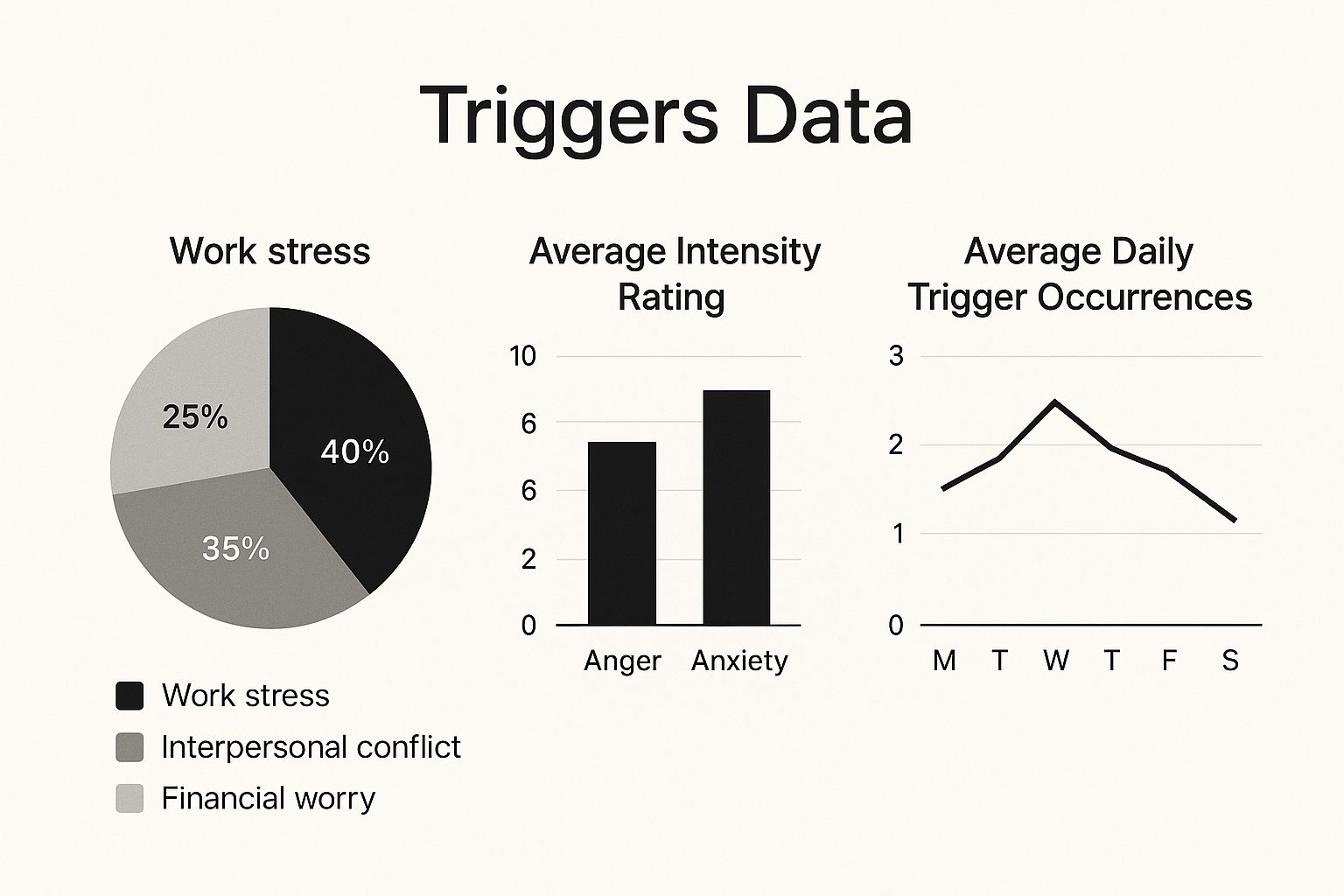It's easy to misunderstand the link between anger and anxiety, but the truth is, they're often deeply connected. Anger frequently acts as a kind of protective shield for underlying anxiety, becoming an outward reaction to internal feelings like fear, helplessness, or just feeling completely overwhelmed. Getting your head around this connection is the very first step to managing both emotions effectively.
The Hidden Link Between Anger and Anxiety

Ever found yourself snapping at someone when you were really just stressed about a deadline? Or felt a sudden flash of road rage when you were actually just anxious about being late? We've all been there. These common moments show just how tangled up anger and anxiety can be. They aren't two separate islands of emotion; more often than not, they're two sides of the same coin.
A great way to think about it is like an iceberg. The anger you show—the sharp words, the clenched fists, the frustration—is just the tip that everyone sees. Beneath the surface, there's a massive, hidden base of ice, which in many cases is pure anxiety. This hidden anxiety is fuelled by feeling vulnerable, a loss of control, or some kind of threat you just don't know how to handle.
Why Anger Feels Easier Than Anxiety
For a lot of us, showing anger can feel much more powerful than admitting we feel anxious. Anger is an active, outward emotion. It makes you feel like you’re doing something about the problem. Anxiety, on the other hand, can feel passive and internal, leaving you feeling helpless or even weak.
When you're faced with what feels like a threat, your body’s natural "fight or flight" response kicks in.
- Fight Response: This is where anger lives. It's a proactive, defensive reaction designed to face the threat head-on.
- Flight Response: This is much more aligned with anxiety—that deep urge to escape or avoid whatever is causing the fear.
When the "flight" response feels too vulnerable, the brain can default to "fight," turning all that anxious energy into an angry outburst. It's a powerful, if misguided, self-preservation instinct. This isn't a character flaw; it's simply your brain's attempt to protect you from what it sees as danger. Your body's internal balancing act is managed by a complex network, and you can learn more about how this works by exploring key facts about the endocannabinoid system.
Anger is often a secondary emotion. It’s the bodyguard for more vulnerable feelings like fear, hurt, or shame. When we feel too exposed by anxiety, anger steps in to shield us.
Recognising this dynamic is the most crucial step toward getting your emotional balance back. By learning to look past that initial flare of anger and asking, "What am I actually anxious about right now?" you can start to deal with the real source of your distress. This guide will walk you through how to untangle these feelings, not just to cope, but to truly understand the 'why' behind your emotional responses.
Why Your Anxiety Might Look Like Anger

Have you ever found yourself boiling with rage when you were really just stressed about running late? Or maybe you’ve snapped at someone you love, not because of anything they did, but because you were secretly drowning in work deadlines?
If that sounds familiar, you're not alone. It's a surprisingly common psychological reflex where our brain decides to mask vulnerability with aggression.
At the core of this is our ancient survival wiring: the fight-or-flight response. When your brain senses a threat—whether it's a genuine danger or a modern-day worry like a looming presentation—it primes your body to either face it head-on (fight) or get away fast (flight).
For a lot of us, that "flight" feeling, which we experience as anxiety, is deeply uncomfortable. It’s a cocktail of vulnerability, uncertainty, and a sense of powerlessness. In those moments, the brain can short-circuit and default to "fight" as a way to feel in control again.
Anger as a Defence Mechanism
Think of it like this: anger is an outward-facing, active emotion. It projects energy and can create a fleeting illusion of power. For the brain, this can feel a whole lot better than the churning, helpless feeling of anxiety.
This isn't some kind of character flaw; it’s just your brain's clumsy attempt to protect you. It's trading a feeling of being scared for one that feels strong and in charge, even if that misplaced anger ends up causing friction in your life.
The connection between these two emotions is incredibly widespread. Here in the UK, more than 40% of people with anxiety disorders also report struggling with significant anger issues. That statistic really highlights how often these feelings get tangled up, creating a cycle that feels impossible to escape. You can dig deeper into this and find useful strategies on how to stop overthinking for a calmer mind in our dedicated guide.
How This Shows Up in Everyday Life
Spotting these patterns in your own day-to-day is the first real step toward getting a handle on them. They can be subtle, but they're always powerful.
- Road Rage: That surge of fury at another driver is often less about their driving and more about your own anxiety over being late.
- Snapping at Home: Being sharp with your family after a tough day isn’t really about them. It’s a release valve for feeling overwhelmed and powerless.
- Controlling Behaviour: Micromanaging people at work or at home can be a way to quieten the internal noise of anxiety about how things will turn out.
Next time you feel that flash of anger, try to hit pause for just a second. Ask yourself, "What am I actually afraid of right now?" This simple question can be the key to looking past the anger to find the anxiety hiding underneath.
Once you understand this connection, you can start to reframe these moments. Instead of beating yourself up for feeling angry, you can recognise it as a red flag. It’s your body's way of telling you that your anxiety is running high and needs some attention. This shift in perspective is a game-changer for finding your emotional balance again.
How to Spot Co-Occurring Anger and Anxiety
Trying to tell the difference between anger and anxiety can feel like trying to unpick two threads that have been twisted together for years. When you're in the middle of it all, strong emotions just blur into one big, overwhelming feeling of distress. The first step towards getting a handle on things is simply gaining a bit of clarity—not to diagnose yourself, but just to understand what your mind and body are trying to tell you.
Recognising the signs is all about noticing what's happening on the inside: the physical feelings, the emotional undercurrents, and the things you feel compelled to do. While each emotion has its own unique fingerprint, the real confusion often lies in the overlap between anger and anxiety. Both can leave you feeling irritable, tense, and staring at the ceiling at 3 AM.
This image gives a great visual of the common triggers for these emotions, showing just how intense and frequent they can be over a typical week.

You can see pretty clearly how everyday pressures, like work stress or arguments, are major drivers. They often kick off intense emotional reactions that can linger for days.
Unpacking the Symptoms
To help you start pinpointing what you're really experiencing, let's break down the common signs. As you read through them, think about which ones feel most familiar in your own life. This isn't about slapping a label on it, but more about building a clearer picture of your internal world.
Understanding your unique blend of symptoms is like being given a map. It doesn't change the terrain, but it shows you a clearer path forward and helps you choose the right tools for the journey.
Below is a simple breakdown comparing the typical signs of anxiety and anger. Pay close attention to the "Overlap" column—this is where you'll see just how tangled up these feelings can get.
Symptoms of Anger vs Anxiety
It's often hard to tell if you're feeling anxious, angry, or a messy combination of both. This table breaks down the common physical, emotional, and behavioural signs to help you spot the difference and, more importantly, see where they intersect.
| Symptom Type | Common in Anxiety | Common in Anger | Overlap |
|---|---|---|---|
| Physical | A racing heart, trembling, shortness of breath, and a churning stomach. | A flushed face, clenched jaw or fists, and increased heart rate. | Muscle tension, headaches, fatigue, and significant sleep disturbances. |
| Emotional | Persistent worry, dread, a sense of impending doom, and feeling on edge. | Frustration, hostility, resentment, and a desire to lash out. | Irritability, feeling overwhelmed, and a general sense of being on edge. |
| Behavioural | Avoiding certain situations or people, restlessness, and difficulty concentrating. | Yelling, sarcasm, confrontational behaviour, or withdrawing from others. | Snapping at others over minor issues and struggling with focus. |
Once you start noticing these patterns, you begin to shift from being controlled by your emotions to understanding them. This awareness is the solid ground you need to stand on to build better coping strategies—ones that address both the anger you can see and the anxiety that might be hiding just beneath the surface.
Understanding The Rise Of Anxiety In The UK

If you’ve ever felt that familiar knot of worry tightening in your chest, you are far from alone. Feeling anxious isn't just a personal struggle; it’s become a shared national experience, growing more common across the UK. Getting to grips with the sheer scale of the issue is the first step in lifting the stigma and showing just how badly we need to talk about it.
That sense of unease so many of us feel is backed up by hard data. In 2022/23, around 37.1% of women and 29.9% of men reported feeling high levels of anxiety. These aren't just numbers; they represent a significant spike since the pandemic, which left a lasting mark on the country's mental health.
Modern Pressures Fuelling The Fire
So, what's behind this collective rise in anxiety? It seems a perfect storm of modern pressures is putting our nervous systems on constant alert. We're navigating challenges that previous generations didn't face in quite the same way.
- Economic Uncertainty: Constant worries about the cost of living, job security, and housing create a persistent, low-level hum of financial stress that’s almost impossible to switch off.
- Digital Overload: We live in an "always-on" culture. The endless stream of notifications, news alerts, and social media comparisons makes it incredibly difficult for our minds to find a moment of genuine peace.
- Social and Global Stress: From political instability to climate concerns, we're more aware than ever of huge problems that feel completely overwhelming and beyond our personal control.
When you feel anxious, it’s easy to think you’re the only one struggling. But these statistics show it's a national conversation. Realising this is a shared experience is the first step towards feeling less isolated in your struggle with anger and anxiety.
By grounding this conversation in reality, we can see that widespread anxiety isn't a sign of individual weakness. It's a completely logical response to an increasingly demanding world. This is a crucial piece of the puzzle for understanding why an emotion like anxiety so often spills over into anger.
For those looking for ways to manage these feelings, our guide to the top CBD solutions for anxiety in the UK offers more insights into natural relief. This widespread experience only highlights how important it is to find support that's both effective and easy to access.
Actionable Strategies to Break the Cycle
Knowing how the anger and anxiety cycle works is one thing, but real change happens when you have a practical toolkit to pull from when emotions are running high. Regaining control is all about learning to step into that feedback loop and calm your nervous system before anxiety gets a chance to boil over into an angry outburst. These aren't complicated, long-term therapies, but simple, effective strategies you can start using today.
The whole idea is to create a bit of space—a pause—between the anxious feeling and the angry reaction. In that small window, you can consciously choose a different path.
Grounding Techniques to Calm Your Nervous System
When anxiety spikes, your body goes on high alert. Grounding techniques are simple, physical exercises designed to pull you out of your racing thoughts and back into the present moment. Think of them as a signal to your brain that the perceived threat isn't real, which helps to switch off that fight-or-flight response.
One of the most effective and straightforward methods is the 5-4-3-2-1 technique. It essentially forces your brain to focus on your immediate surroundings rather than the fears swirling around in your head.
- 5: Name five things you can see around you. (e.g., a blue pen, a crack in the ceiling, a dusty plant).
- 4: Acknowledge four things you can feel. (e.g., the texture of your trousers, the cool surface of a desk, your feet flat on the floor).
- 3: Listen for three things you can hear. (e.g., the hum of a computer, distant traffic, your own breathing).
- 2: Identify two things you can smell. (e.g., leftover coffee, hand sanitiser).
- 1: Name one thing you can taste. (e.g., mint from your toothpaste, the water you just drank).
This exercise is brilliant because it interrupts the spiralling thoughts that fuel anxiety, giving your nervous system a chance to stand down before anger takes the stage.
Challenge Anxious Thoughts with CBT Principles
Cognitive Behavioural Therapy (CBT) is based on a simple but powerful idea: our thoughts, feelings, and behaviours are all connected. Anxious thoughts often act as the kindling for angry reactions. If you can learn to spot and challenge those thoughts, you can effectively cut off the fuel supply.
Start by becoming a bit of a detective with your own mind. The next time you feel that surge of anxiety or anger, ask yourself a few questions:
- What am I telling myself right now? (e.g., "I'm going to fail this presentation and everyone will think I'm incompetent.")
- Is there any real evidence for this thought? (Have you failed every single presentation before? Is it 100% certain this will happen?)
- What's a more balanced way of looking at this? (e.g., "I'm nervous, but I've prepared. It might not be perfect, but I'll do my best.")
This process isn't about slapping on some forced positivity; it's about shifting your perspective from a catastrophic one to something much more realistic. Over time, you can actually retrain your brain to stop automatically jumping to the worst-case scenario that so often triggers both anger and anxiety.
Find Healthy Outlets for Emotional Release
Both anxiety and anger create a build-up of intense energy in the body. If that energy has nowhere to go, it will find a way out—often as an angry outburst. Finding healthy outlets is absolutely crucial for managing this emotional pressure cooker.
Physical activity is one of the most powerful tools in your arsenal. A brisk walk, a good run, or a high-intensity workout helps your body metabolise stress hormones like cortisol and adrenaline, which are key players in the anxiety response. It quite literally helps you "burn off" that angry energy.
Journaling is another incredibly effective outlet. The act of writing down your anxious thoughts and angry feelings gets them out of your head and onto paper, which can make them feel much less overwhelming. It gives you a safe space to vent without causing any harm to your relationships. For more ways to find calm, you can explore our list of natural remedies and relief tips for anxiety. Each strategy works to address the root cause, empowering you with a range of methods for emotional regulation.
When to Seek Professional Support
While getting a handle on your own emotions is a powerful skill, there are times when self-help strategies just aren't enough to manage the knot of anger and anxiety.
Recognising you need more structured support isn't a sign of weakness. Far from it. It's a proactive and genuinely courageous step towards feeling better for the long haul. But how do you know when you've reached that point?
A good rule of thumb is this: if your emotions consistently feel overwhelming or are starting to throw a wrench in your daily life, it might be time to chat with a professional.
Clear Signs You Could Use More Support
It can be tough to make the call, but certain patterns are pretty clear indicators that it's time to ask for help. Think about reaching out for professional guidance if any of these sound familiar:
- Damaged Relationships: Is your anger sparking frequent arguments or making loved ones keep their distance?
- Workplace Issues: Are you finding it hard to keep your temper in check at work, or is anxiety tanking your performance?
- Physical Symptoms: Are you constantly dealing with tension, headaches, or sleep troubles that just won't let up?
- Avoidance Behaviour: Has your anxiety become so intense that it stops you from leaving the house, seeing friends, or doing things you used to love?
Reaching out for help is not giving up; it is refusing to give up. It's an act of taking back control over your emotional health and investing in a calmer, more balanced future.
Here in the UK, the first step is often the easiest one. You can simply book an appointment with your GP to talk about how you're feeling.
They can help rule out any physical causes for your symptoms and point you towards specialised mental health services. This could include NHS talking therapies, which offer proven treatments like CBT. Taking that first step can put you on a structured path to finally understanding and managing both your anger and anxiety.
Got Questions About Anger and Anxiety?
It's completely normal to have questions when you're trying to get your head around the tangled relationship between anger and anxiety. Let's clear up some of the most common ones to give you a better understanding of these powerful emotions.
Can Anxiety Actually Cause Anger?
Yes, it absolutely can. Think of it this way: anxiety often puts you on high alert, making you feel threatened or like you've lost control.
When that feeling gets too much to handle, your brain's "fight or flight" response can kick in, and sometimes, 'fight' comes out as anger. For a lot of people, a flash of anger feels more empowering than sitting with the raw vulnerability of anxiety.
Is an Anxiety Attack the Same as an Angry Outburst?
They're different, but they can definitely be connected. An anxiety attack is an internal storm of intense fear, often with physical symptoms like a racing heart, dizziness, or shortness of breath.
An angry outburst, on the other hand, is an external explosion of rage – think yelling, slamming doors, or aggressive behaviour.
Here's the link, though: the overwhelming terror of an anxiety attack can sometimes flip the switch into an angry outburst. It becomes a desperate attempt to react against the feeling of being trapped or powerless.
What Lifestyle Changes Can Help with Both?
Making a few tweaks to your daily habits can make a massive difference in managing both anger and anxiety. You don't have to change everything at once, but focusing on these areas can really help.
- Regular exercise is fantastic for burning off stress hormones like cortisol and adrenaline. Even a brisk walk can work wonders.
- A balanced diet helps keep your mood and energy levels on an even keel, preventing the spikes and crashes that can fray your nerves.
- Prioritising consistent sleep is non-negotiable. When you're exhausted, your emotional fuse is much, much shorter.
- Cutting back on stimulants like caffeine and alcohol can have a surprisingly powerful calming effect on your entire nervous system.
Even small, consistent changes here can build up to support your overall emotional wellbeing in a big way.
Ready to explore natural ways to manage your wellbeing? SMOKO CBD offers premium, UK-made CBD products to help you find calm and balance. Discover our range at https://smokocbd.com.









